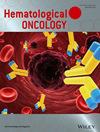体外光移植术治疗进展期皮肤t细胞淋巴瘤的早期干预。
IF 3.3
4区 医学
Q2 HEMATOLOGY
引用次数: 0
摘要
伴有进行性疾病的皮肤t细胞淋巴瘤患者通常在反应和复发周期中接受一系列皮肤定向和全身治疗方案。体外光移植术(Extracorporeal photopheresis, ECP)是一种有效且安全的全身治疗选择,通常用于疾病晚期,通常在几种其他治疗失败后使用。ECP在反应率、到下一次治疗的时间和耐受性方面具有优势,这可能支持其在治疗周期早期用于进展/进展的疾病。本文章由计算机程序翻译,如有差异,请以英文原文为准。
Early intervention of extracorporeal photopheresis for advancing/progressing cutaneous T-cell lymphoma
Patients with cutaneous T-cell lymphoma with progressive disease typically undergo a series of skin-directed and systemic therapy regimens during cycles of response and relapse. Extracorporeal photopheresis (ECP) is an effective and safe systemic treatment option, often reserved for later stages of disease and typically employed after failure of several other therapies. ECP has benefits in response rate, time to next treatment, and tolerability that may support its use earlier in the treatment cycle for advancing/progressing disease.
求助全文
通过发布文献求助,成功后即可免费获取论文全文。
去求助
来源期刊

Hematological Oncology
医学-血液学
CiteScore
4.20
自引率
6.10%
发文量
147
审稿时长
>12 weeks
期刊介绍:
Hematological Oncology considers for publication articles dealing with experimental and clinical aspects of neoplastic diseases of the hemopoietic and lymphoid systems and relevant related matters. Translational studies applying basic science to clinical issues are particularly welcomed. Manuscripts dealing with the following areas are encouraged:
-Clinical practice and management of hematological neoplasia, including: acute and chronic leukemias, malignant lymphomas, myeloproliferative disorders
-Diagnostic investigations, including imaging and laboratory assays
-Epidemiology, pathology and pathobiology of hematological neoplasia of hematological diseases
-Therapeutic issues including Phase 1, 2 or 3 trials as well as allogeneic and autologous stem cell transplantation studies
-Aspects of the cell biology, molecular biology, molecular genetics and cytogenetics of normal or diseased hematopoeisis and lymphopoiesis, including stem cells and cytokines and other regulatory systems.
Concise, topical review material is welcomed, especially if it makes new concepts and ideas accessible to a wider community. Proposals for review material may be discussed with the Editor-in-Chief. Collections of case material and case reports will be considered only if they have broader scientific or clinical relevance.
 求助内容:
求助内容: 应助结果提醒方式:
应助结果提醒方式:


